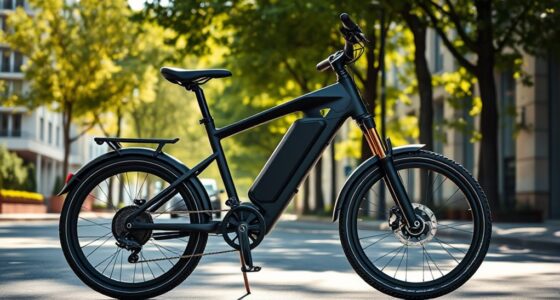For precise astrophotography, we recommend the iEXOS-100-2 PMC-Eight system, which features a reliable belt drive for smooth, accurate tracking. Its high load capacity, quiet operation, and compatibility with popular control protocols make it a top choice. Ease of setup and minimal maintenance also add to its appeal. Stay with us to explore detailed insights on why this mount stands out among the best options available.
Key Takeaways
- Look for mounts featuring high-quality, precision-engineered belt drive systems for smooth, accurate long-exposure astrophotography.
- Ensure the mount supports sufficient load capacity for your camera and accessories without exceeding limits.
- Choose models with quiet operation and minimal backlash, ideal for delicate astrophotography sessions.
- Verify compatibility with popular control protocols like ASCOM or INDI for seamless integration and remote operation.
- Opt for mounts with user-friendly setup features, such as polar alignment aids and wireless controls, for efficient calibration.
iEXOS-100-2 PMC-Eight Astrophotography Tracker System with WiFi & Bluetooth
If you’re serious about astrophotography and need precise, reliable tracking, the iEXOS-100-2 PMC-Eight system is an excellent choice. Its advanced architecture features eight independent CPUs, delivering exceptional responsiveness and stability. The system’s mechanical design includes clutched dual-axis worm gears and quiet stepper motor belt drives, ensuring smooth, accurate movements. With built-in polar alignment aids and altitude control, setup becomes fast and straightforward. Plus, its WiFi and Bluetooth connectivity, paired with the ExploreStars app, allows easy control and navigation. This combination of precision engineering and user-friendly features makes the iEXOS-100-2 a top-tier mount for capturing stunning astrophotos.
Best For: serious astrophotographers and astronomers seeking precise, reliable tracking and easy setup for capturing high-quality images of celestial objects.
Pros:
- Advanced architecture with eight independent CPUs for exceptional responsiveness and stability
- Mechanical design with clutched dual-axis worm gears and quiet stepper motor belt drives ensures smooth, accurate movements
- Built-in polar alignment aids and altitude control simplify setup and improve tracking accuracy
Cons:
- May be more expensive compared to entry-level astrophotography mounts
- Requires a compatible device with WiFi or Bluetooth for full control, which might limit options for some users
- Setup and calibration might still require some technical knowledge for optimal performance
Factors to Consider When Choosing Equatorial Mounts With Belt Drive Systems

When selecting an equatorial mount with a belt drive system, we need to consider several key factors to guarantee it meets our needs. These include the precision of the belt drive, the mount’s load capacity, and how quietly it operates. Additionally, compatibility features and ease of setup play vital roles in making the right choice.
Belt Drive Precision
Belt drive precision in equatorial mounts hinges on several key factors that directly influence tracking accuracy and stability. The quality of the belt, its tension, and pulley alignment are crucial, as they determine how smoothly and accurately the mount moves. High-quality belts can achieve sub-arcminute or even arcsecond-level tracking, essential for long-exposure astrophotography. Proper calibration and maintenance of belt tension are vital to prevent slippage, reduce vibrations, and ensure consistent movement. Belt drives typically offer quieter operation with less backlash and gear slop, resulting in more reliable tracking. Ultimately, investing in a mount with well-designed belt drive components and paying attention to setup and upkeep will significantly enhance your astrophotography precision.
Load Capacity Limits
How much weight your equatorial mount with a belt drive can handle is essential for achieving stable and accurate tracking. Exceeding the recommended load capacity can cause gear slippage, increased backlash, and motor strain, all of which compromise performance. Manufacturers specify the load limits based on the mount’s design, gear strength, and motor power, so it’s crucial to follow these guidelines. Packing your mount beyond its capacity risks damaging components and reduces lifespan. Properly balancing your equipment within the specified limits not only maintains optimal performance but also minimizes stress on the belt drive system. Ensuring your setup stays within weight limits helps achieve consistent tracking accuracy, which is vital for high-quality astrophotography. Always check load specifications before mounting your gear.
Motor Noise Levels
Motor noise levels are a key factor to contemplate when selecting an equatorial mount with a belt drive system, as quieter operation enhances the overall astrophotography experience. Belt drives typically produce less noise than traditional gear systems, making long sessions more comfortable. The quality of belts and pulleys greatly influences noise levels; high-quality components minimize vibrations and sound. Additionally, the motor type impacts noise, with stepper motors generally operating more quietly than brushed DC motors when paired with belt drives. Proper belt tensioning is essential—loose belts can slip and generate extra noise. Advances in belt drive technology have led to near-silent operation, which is especially important during delicate, long exposure captures where minimal disturbance is crucial.
Compatibility Features
Choosing an equatorial mount with a belt drive system means ensuring it can work smoothly with your existing astrophotography gear. Compatibility features are vital for seamless integration with cameras, guide scopes, and accessories. An important aspect is support for control protocols like ASCOM, INDI, or proprietary software, which enables the mount to communicate effectively with planetarium and imaging applications. Connectivity options such as WiFi, Bluetooth, or USB provide flexible, reliable links. It’s also essential to verify that the mount can handle your gear’s size and weight without sacrificing stability or tracking accuracy. Ultimately, look for mounts that support quick, secure attachment of accessories through compatible dovetail plates and brackets, making setup and operation more efficient.
Setup Ease
Equatorial mounts with belt drive systems are known for their smooth operation and minimal gear backlash, which considerably simplifies the setup process. Their design often includes precise polar alignment aids like sight holes and altitude controls, making initial setup quicker and more accurate. Belt drives typically require less maintenance and fewer adjustments than traditional gear systems, saving time. Many mounts feature quick-attach mechanisms and intuitive controls, allowing for faster alignment and setup. Compatibility with smartphone or tablet control apps further streamlines the process by enabling wireless adjustments and setup steps. Overall, these features combine to reduce setup complexity, making belt drive mounts ideal for both beginners and experienced astrophotographers seeking efficient and hassle-free assembly before imaging sessions.
Frequently Asked Questions
How Do Belt Drive Systems Improve Tracking Accuracy?
Belt drive systems improve tracking accuracy by reducing gear backlash and minimizing vibrations, resulting in smoother movement. We notice that they provide more precise control over the mount’s motion, which is essential for long-exposure astrophotography. The belts also help maintain consistent speed, preventing star trails and ensuring sharp images. Overall, they make our tracking more reliable and help us capture clearer, more detailed celestial images.
Are Belt Drive Mounts Suitable for Astrophotography Beginners?
Belt drive mounts are great for beginners because they’re like training wheels for your astrophotography journey. We’ve seen newcomers capture stunning images without complex setups, thanks to the smooth, quiet tracking these mounts provide. While they might seem advanced, many models are user-friendly and forgiving, helping newcomers learn the ropes while still delivering impressive results. So yes, belt drive mounts are a solid choice for starting out!
What Maintenance Is Required for Belt Drive Equatorial Mounts?
We regularly check the belt tension to guarantee smooth operation and prevent slipping. Cleaning the belts and mount gears with a soft brush or cloth keeps dust and debris away, maintaining performance. Lubricating moving parts with appropriate lubricants every few months helps reduce wear. We also inspect for any signs of wear or damage, replacing belts if needed. Proper maintenance keeps our belt drive mounts precise and reliable for astrophotography.
Can Belt Drive Systems Handle Heavy Astrophotography Equipment?
Sure, belt drive systems can handle heavy astrophotography gear, but don’t expect them to perform miracles. While many models are designed for stability and precision, pushing their limits with excessive weight can strain the belts and motors. We recommend choosing mounts specifically rated for your gear’s weight, ensuring smooth tracking without risking damage. After all, even the best systems need proper respect and careful handling.
Do Belt Drive Mounts Reduce Periodic Error Compared to Gear Drives?
Yes, belt drive mounts generally reduce periodic error compared to gear drives. We’ve found that belts create smoother, quieter movements, minimizing the backlash and gear imperfections that cause periodic error. This leads to more precise tracking during astrophotography sessions. While no mount is perfect, belt drive systems markedly improve stability and accuracy, making them our go-to choice for capturing sharp, high-quality images of the night sky.
Conclusion
So, there you have it—our top pick for an equatorial mount with belt drive precision. Because who wouldn’t want a system that’s quieter than your neighbor’s midnight karaoke, yet still holds your gear like a fortress? Remember, in astrophotography, it’s not just about the stars you chase but the silence you keep. After all, the universe isn’t rushing, so why should your mount? Happy stargazing—quietly, of course.









